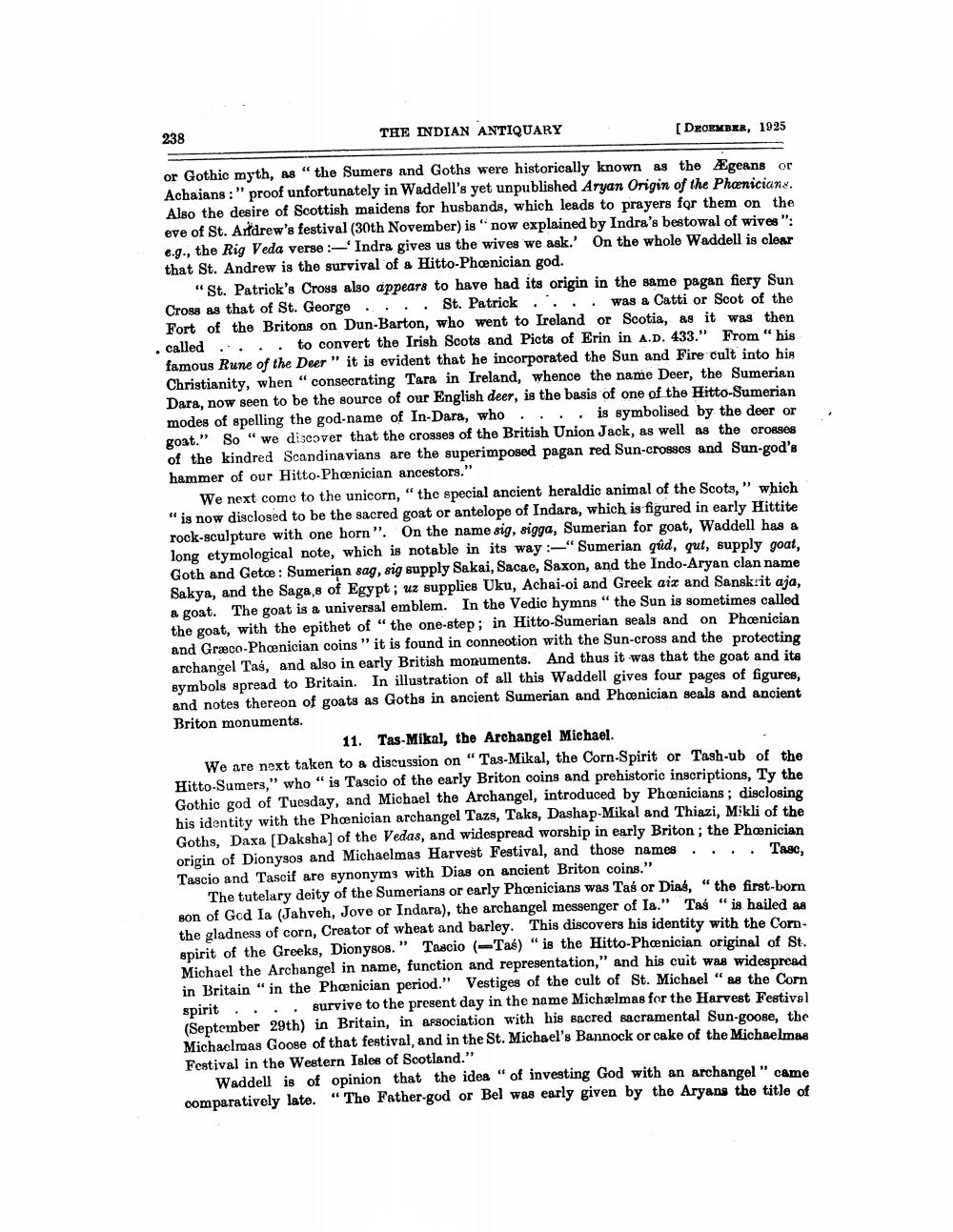________________
238
THE INDIAN ANTIQUARY
[ DECEMBER, 1925
or Gothic myth, as "the Sumers and Goths were historically known as the Ægeans or Achaians :" proof unfortunately in Waddell's yet unpublished Aryan Origin of the Phænicians. Also the desire of Scottish maidens for husbands, which leads to prayers for them on the eve of St. Andrew's festival (30th November) is ' now explained by Indra's bestowal of wives": e.g., the Rig Veda verge :-—Indra gives us the wives we ask.' On the whole Waddell is clear that St. Andrew is the survival of a Hitto-Phoenician god.
"St. Patrick's Cross also appears to have had its origin in the same pagan fiery Sun Cross as that of St. George ... St. Patrick ... was a Catti or Scot of the Fort of the Britons on Dun-Barton, who went to Ireland or Scotia, as it was then called .... to convert the Irish Scots and Picts of Erin in A.D. 433." From "his famous Rune of the Deer" it is evident that he incorporated the Sun and Fire cult into his Christianity, when "consecrating Tara in Ireland, whence the name Deer, the Sumerian Dara, now seen to be the source of our English deer, is the basis of one of the Hitto-Sumerian modes of spelling the god-name of In-Dara, who.... is symbolised by the deer or goat." So " we discover that the crosses of the British Union Jack, as well as the crosses of the kindred Scandinavians are the superimposed pagan red Sun-Crosses and Sun-god's hammer of our Hitto-Phænician ancestors."
We next come to the unicorn, “the special ancient heraldic animal of the Scots," which "is now disclosed to be the sacred goat or antelope of Indara, which is figured in early Hittite rock-sculpture with one horn". On the name sig, sigga, Sumerian for goat, Waddell has a long etymological note, which is notable in its way :“Sumerian qüd, gut, supply goat, Goth and Getoe: Sumerian sag, sig supply Sakai, Sacae, Saxon, and the Indo-Aryan clan name Sakya, and the Saga,s of Egypt; uz supplies Uku, Achai-oi and Greek aix and Sansk it aja, a goat. The goat is a universal emblem. In the Vedic hymns “the Sun is sometimes called the goat, with the epithet of "the one-step; in Hitto-Sumerian seals and on Phænician and Græco-Phænician coins " it is found in connootion with the Sun-cross and the protecting archangel Tas, and also in early British monuments. And thus it was that the goat and its symbols spread to Britain. In illustration of all this Waddell gives four pages of figures, and notes thereon of goats as Goths in ancient Sumerian and Phænician seals and ancient Briton monuments.
11. Tas Mikal, the Archangel Michael. We are next taken to a discussion on "Tas-Mikal, the Corn-Spirit or Tash-ub of the Hitto-Sumers," who " is Tascio of the early Briton coins and prehistoric inscriptions, Ty the Gothic god of Tuesday, and Michael the Archangel, introduced by Phænicians; disclosing his identity with the Phænician archangel Tazs, Taks, Dashap-Mikal and Thiazi, Mikli of the Goths, Daxa (Daksha) of the Vedas, and widespread worship in early Briton; the Phænician origin of Dionysos and Michaelmas Harvest Festival, and those names .. Tasc, Tascio and Tascif are synonyms with Dias on ancient Briton coins."
The tutelary deity of the Sumerians or early Phænicians was Tas or Dias, "the first-born Bon of God Ia (Jahveh, Jove or Indara), the archangel messenger of la." Tas "is hailed as the gladness of corn, Creator of wheat and barley. This discovers his identity with the Cornspirit of the Greeks, Dionysos." Tascio (-Tas) " is the Hitto-Phænician original of St. Michael the Archangel in name, function and representation," and his cuit was widespread in Britain " in the Phænician period.” Vestiges of the cult of St. Michael " as the Corn spirit.... survive to the present day in the name Michalmas for the Harvest Festival (September 29th) in Britain, in association with his sacred sacramental Sun-goose, the Michaelmas Goose of that festival, and in the St. Michael's Bannock or cake of the Michaelmas Festival in the Western Isles of Scotland."
Waddell is of opinion that the idea “ of investing God with an archangel " came comparatively late. “The Father-god or Bel was early given by the Aryans the title of




